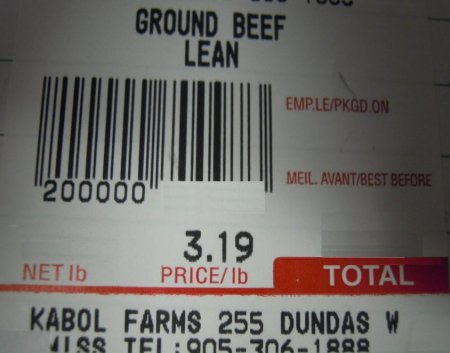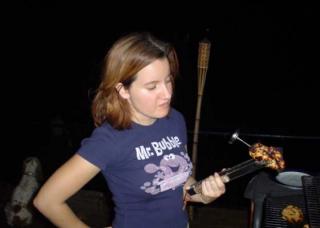When it comes to social issues I’m a bit of a libertarian hippy. I’ve looked the part (big bushy beard and longer thinning hair); used to play ultimate frisbee (poorly); and, our first-born was delivered at home. I saw The Dead, after Jerry, but I never really got into Phish.
The philosophy I’ve embraced around food safety is let people eat what they want. 
Extension folks like me should provide the best available evidence culled from the literature to help eaters calculate the risks and benefits of food choices. Present the info in a compelling way and then step back to let the individual do their thing.
Hopefully the choice results in the least amount of barf.
As North Carolina moves down the path of adopting the U.S FDA model food code, restaurant patrons will be able to order an undercooked burger, and the restaurant able to serve it, without risking a lower inspection grade. The responsibility to communicate the risks associated with undercooked burgers, and other raw/undercooked animal-derived foods (eggs, poultry, fish) lies with the restaurant. Risk must be disclosed somehow, and a reminder presented to the patron when they order.
Temperature guidance for cooking burgers doesn’t change (the food code suggests 155F for 15 seconds or 160F for 5-log reduction), just the ability for the restaurant to respond to patron requests – with the caveat of the mandatory risk discussion. And the risk dialogue applies to stuff like Caesar salad dressing, hollandaise sauce and sushi.
According to Kathleen Purvis of the Charlotte Observer:
The N.C. Commission for Public Health this week approved the adoption of most of the 2009 federal food code. Among other changes, it would allow restaurant customers to order raw or undercooked foods if the restaurant provides a warning – usually a note on the menu – to remind you it’s dangerous. A similar procedure is already followed in many states, including South Carolina.
“This really does represent the largest comprehensive change in our food safety rules in over 30 years.”
How big is that? It’s so big that when we called chef-owner Tom Condron at The Liberty, a pub known for its burgers, he was actually willing to come to the phone during the lunch rush.
“About time,” he said happily. “The quality of beef and the preparation have come so far. It’s about time North Carolina stepped up. For restaurants like us and others that grind in-house and take all the steps to make sure we get top-quality beef, it’s an important change.”
Michael says adopting the federal food code allows North Carolina to use the latest research in forming its own food safety standards.
“The majority of states use it,” he said. “It’s the most comprehensive standard out there.”
But the big one, Michael admitted, is the standard on allowing customers to request raw or undercooked foods. As it is now, undercooked burgers are often served to customers even though the restaurant isn’t supposed to do it – a sort of “wink-and-nudge” approach to food safety.
What the new regulation would do is put the decision into the hands of the consumer. The restaurant would have to tell you that you’re ordering a food that isn’t cooked to a safe level and it has to tell you that eating undercooked or raw foods puts you at a risk of foodborne illness, such as salmonella.
“This consumer advisory will be more helpful in ensuring consumers know they’re increasing their risk.”
I’m not sure what knowing the source well has to do with evaluating whether the primal cuts have pathogen-containing poop on the surface and in-house grinding can spread that surface bacteria just as well as at a processing plant.
Regardless of the source or method, undercooked ground beef carry food safety risks; restaurants with a positive food safety culture will communicate this effectively – or won’t serve it at all.
(1).jpg) “gastroenteritis is seven days, it is only five,” and was sent home.
“gastroenteritis is seven days, it is only five,” and was sent home.
 weight on May 31, 2012 from the Kabul Farms store located at 255 Dundas Street West, Mississauga, Ontario. The packages bear a sticker with the product name, the store’s name and the price.
weight on May 31, 2012 from the Kabul Farms store located at 255 Dundas Street West, Mississauga, Ontario. The packages bear a sticker with the product name, the store’s name and the price.
.jpg) both teams didn’t suck.
both teams didn’t suck. end hamburgers continues: Parisians are paying 29 euros, or just over $36, for the popular burger at Ralph’s, the Hamptons-Wyoming-chic restaurant in the palatial Ralph Lauren store.
end hamburgers continues: Parisians are paying 29 euros, or just over $36, for the popular burger at Ralph’s, the Hamptons-Wyoming-chic restaurant in the palatial Ralph Lauren store. spans two decades of teaching, mentoring and research.”
spans two decades of teaching, mentoring and research.”
.jpg) hamburger disease.
hamburger disease.

.jpg) essentially recalled everything that producer has put out."
essentially recalled everything that producer has put out.".jpg) the remainder children from a variety of area schools, now including Stittsville Public School.
the remainder children from a variety of area schools, now including Stittsville Public School.
(2).jpg) imagination.
imagination..jpeg) of 43 cross-contamination events per household. They concluded Thermy had not been successful.
of 43 cross-contamination events per household. They concluded Thermy had not been successful.(1).jpg)